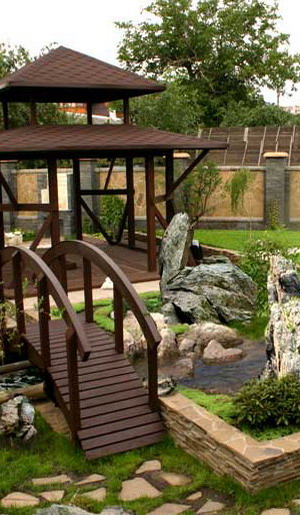 Probably, every gardener, remembering his personal plot on long winter evenings, dreams of making drastic changes to it. It’s time to come to grips with this issue, because design development is not an easy task and requires a lot of time. Moreover, a modern personal plot often performs not only the function of a “breadwinner”. City life, poor in bright colors and positive emotions; pushes us to create not just a garden, but a piece of natural beauty and comfort.
Probably, every gardener, remembering his personal plot on long winter evenings, dreams of making drastic changes to it. It’s time to come to grips with this issue, because design development is not an easy task and requires a lot of time. Moreover, a modern personal plot often performs not only the function of a “breadwinner”. City life, poor in bright colors and positive emotions; pushes us to create not just a garden, but a piece of natural beauty and comfort.
Where to begin?
The type of soil, its mechanical composition, acidity, the content of minerals and humus, the depth of groundwater are the main data that any gardener needs. If the site has been in use for a long time, then some features may be known to you. But if the site is only acquired, it is simply necessary to determine the above indicators. Soil analysis is usually carried out in agrochemical laboratories, but the main properties of the soil can be determined independently.
Considering the location, landscape, and soil characteristics of the site, consider which plants will be comfortable growing in such conditions. Do not forget that with the help of agrotechnical measures (introduction of mineral and organic fertilizers, lime, sawdust), soil properties can be adjusted, making them more favorable for certain plants.
Need an idea
The first thing that starts work is an idea. If the site is new, then decide in what style you would like to see it (regular, landscape, rustic, oriental, modern). Try to avoid mixing styles in at least one plan view. In doing so, keep in mind the characteristics of the site. For example, if the area you have chosen is well lit, the soil is sandy or light loam with a pH in the region of 4–5.5, then an oriental-style garden from various conifers of rhododendrons, erica, and heather will grow perfectly here. Medium to heavy loamy soils with a pH close to 6–7 are good for roses , irises and many water plants.
If the site is already designed, clearly define what you want to change. Try not to set ambitious goals for yourself.
Mistake #1
To improve their site, many housewives simply rush headlong to flower shops, nurseries, markets, buying up all the plants they like on their way. Then breathtaking flower beds, curbs, alpine slides, and ponds appear in the garden. The emerging desire to “plant everything more and more beautifully” leads to the formation of a “vinaigrette” from ornamental plants. Such landscaping loses its aesthetics and dooms the hostess to constant transplants.
Without a plan – nowhere
Draw a site plan on graph paper (scale 1:100, 1:200), mark the cardinal directions. Enter into the drawing everything that is present on your site: residential and non-residential buildings, trees and shrubs, beds, flower beds.
Then you can start designing. The site project is being done on the same scale. First of all, only buildings and landings that you plan to leave are brought into it. With a dotted line, break the site into functional zones (economic zone, recreation area, garden, kitchen garden). Define viewpoints – a point from which a beautiful view opens. Decide on the location of the tracks. Based on the chosen style, start designing green spaces (trees, shrubs, flower beds, lawns, etc.), focusing on the projection points of viewpoints.
Color game
The main thing is that your garden does not create a feeling of variegation. Choose colors according to the principle of color compatibility, it can be both contrast and color similarity. In the background, it is better to place plants of cold, blue-blue shades.
This design is achieved with the help of dark-leaved species, blue and blue flower beds. And warm tones in sunlight give the impression of loved ones. Thus, the colors are warm, in the foreground, visually approaching. Remember that the main color of the site is green (calm shades), do not try to overload it with a mass of bright spots.
Of course, designing a site on your own is not an easy task. Professional designers, in addition to color, solve compositional problems, as well as perspective problems. However, given the basic rules, you can also transform the site and make it more harmonious.
More about the design of the garden plot and landscape design on the website sad6sotok.ru







